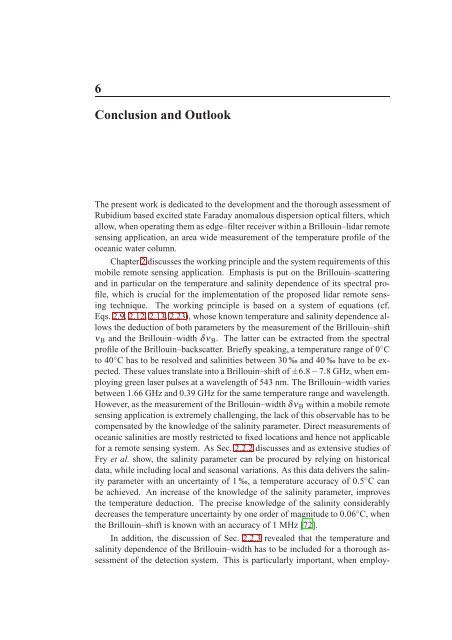Assessment of a Rubidium ESFADOF Edge-Filter as ... - tuprints
Assessment of a Rubidium ESFADOF Edge-Filter as ... - tuprints
Assessment of a Rubidium ESFADOF Edge-Filter as ... - tuprints
Create successful ePaper yourself
Turn your PDF publications into a flip-book with our unique Google optimized e-Paper software.
6<br />
Conclusion and Outlook<br />
The present work is dedicated to the development and the thorough <strong>as</strong>sessment <strong>of</strong><br />
<strong>Rubidium</strong> b<strong>as</strong>ed excited state Faraday anomalous dispersion optical filters, which<br />
allow, when operating them <strong>as</strong> edge–filter receiver within a Brillouin–lidar remote<br />
sensing application, an area wide me<strong>as</strong>urement <strong>of</strong> the temperature pr<strong>of</strong>ile <strong>of</strong> the<br />
oceanic water column.<br />
Chapter 2 discusses the working principle and the system requirements <strong>of</strong> this<br />
mobile remote sensing application. Emph<strong>as</strong>is is put on the Brillouin–scattering<br />
and in particular on the temperature and salinity dependence <strong>of</strong> its spectral pr<strong>of</strong>ile,<br />
which is crucial for the implementation <strong>of</strong> the proposed lidar remote sensing<br />
technique. The working principle is b<strong>as</strong>ed on a system <strong>of</strong> equations (cf.<br />
Eqs. 2.9, 2.12, 2.13, 2.23), whose known temperature and salinity dependence allows<br />
the deduction <strong>of</strong> both parameters by the me<strong>as</strong>urement <strong>of</strong> the Brillouin–shift<br />
ν B and the Brillouin–width δν B . The latter can be extracted from the spectral<br />
pr<strong>of</strong>ile <strong>of</strong> the Brillouin–backscatter. Briefly speaking, a temperature range <strong>of</strong> 0 ◦ C<br />
to 40 ◦ C h<strong>as</strong> to be resolved and salinities between 30 ‰ and 40 ‰ have to be expected.<br />
These values translate into a Brillouin–shift <strong>of</strong> ±6.8−7.8 GHz, when employing<br />
green l<strong>as</strong>er pulses at a wavelength <strong>of</strong> 543 nm. The Brillouin–width varies<br />
between 1.66 GHz and 0.39 GHz for the same temperature range and wavelength.<br />
However, <strong>as</strong> the me<strong>as</strong>urement <strong>of</strong> the Brillouin–width δν B within a mobile remote<br />
sensing application is extremely challenging, the lack <strong>of</strong> this observable h<strong>as</strong> to be<br />
compensated by the knowledge <strong>of</strong> the salinity parameter. Direct me<strong>as</strong>urements <strong>of</strong><br />
oceanic salinities are mostly restricted to fixed locations and hence not applicable<br />
for a remote sensing system. As Sec. 2.2.2 discusses and <strong>as</strong> extensive studies <strong>of</strong><br />
Fry et al. show, the salinity parameter can be procured by relying on historical<br />
data, while including local and se<strong>as</strong>onal variations. As this data delivers the salinity<br />
parameter with an uncertainty <strong>of</strong> 1 ‰, a temperature accuracy <strong>of</strong> 0.5 ◦ C can<br />
be achieved. An incre<strong>as</strong>e <strong>of</strong> the knowledge <strong>of</strong> the salinity parameter, improves<br />
the temperature deduction. The precise knowledge <strong>of</strong> the salinity considerably<br />
decre<strong>as</strong>es the temperature uncertainty by one order <strong>of</strong> magnitude to 0.06 ◦ C, when<br />
the Brillouin–shift is known with an accuracy <strong>of</strong> 1 MHz [72].<br />
In addition, the discussion <strong>of</strong> Sec. 2.2.3 revealed that the temperature and<br />
salinity dependence <strong>of</strong> the Brillouin–width h<strong>as</strong> to be included for a thorough <strong>as</strong>sessment<br />
<strong>of</strong> the detection system. This is particularly important, when employ-
















